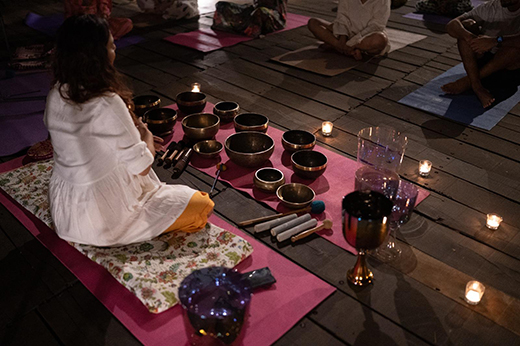Anoopama Mukerjee Lohana
24-Oct-2025
Engaging the senses through multisensory meditation can help release stress, rewire the nervous system, and cultivate lasting calm.
Inputs by: Anoopama Mukerjee Lohana, Experiential Wellness Consultant & COO – Siddhayu Wellness Experience
Our interactions and expressions of life are but a dramatic Sensorial Journey, through all that we observe, absorb, perceive and process. For most, this interlude, with people, animals, spaces, circumstances, environments and our ownselves too, culminates in our reaction and resistance to them. Whereas the true experience of life lies in responding and flowing with.
This vital discord is why the world today is reeling under an emotional and mental epidemic, whether we express and accept it or not!
Our senses, both physical and subtle ( intuition, devotion, purpose), are tirelessly scanning light, sound, scent, and movement, even before we’ve had time to “think”. These fast, protective responses are innate survival tools, meant to protect our physical, mental and emotional bodies. But, sometimes, trauma (read: impact or experience) can leave us, consciously, and sub consciously, stuck on high alert!
Everyday sounds, lights, textures, or smells may imprint or retrieve old energetic scars of threat, exhaustion, anxiety, grief, fear, loss and spirals of stress. Untangling these knots and re-learning to meet the world through the senses gently and consciously, can be a powerful way back to balance. This is where multi-sensory meditation techniques, both ancestral and New age, work their magic to realign us.

What Is Multisensory Meditation?
Have you ever noticed how a soft melody can instantly calm your thoughts or how the scent of lavender can make you feel peaceful after a long day? Maybe you’ve felt your mind slow down when watching waves crash against the shore or the warm sun brush across your skin. These are all examples of how your senses influence your emotional state and that’s exactly what multisensory meditation is all about.
Why does Multisensory Meditation work?
Mindfulness-based practices consistently reduce anxiety and depression across diverse groups, and they also help people with trauma-related symptoms. Multiple trials and reviews show meaningful improvements. What’s especially relevant for healing is how mindfulness works: it strengthens the brain’s ability to feel internal body signals (like heartbeat and breath) and use them to regulate emotions.
Multisensory meditation goes beyond traditional mindfulness by inviting all your senses into the moment. It’s not limited to quiet breathing or stillness; instead, it weaves together sound, touch, sight, smell, and even taste to create a deeply immersive experience. You might light a candle, listen to ocean sounds, hold a smooth crystal, or sip herbal tea while meditating. Each sense adds another layer of presence, helping you reconnect with your body and quiet the noise of your mind.
This approach fits beautifully within the broader concept of wellness. Wellness isn’t just about eating right or exercising; it's about nurturing balance in every aspect of your life: physical, emotional, mental, and spiritual. When wellness meets multisensory meditation, the practice becomes more than relaxation; it becomes a way to align all parts of yourself. Through simple sensory rituals, you can reduce stress, heighten awareness, and cultivate a sense of wholeness that carries into your daily life.
Multisensory meditation brings sight, sound, smell, touch, and taste into that healing conversation. It is primarily designed with gentle inputs so your nervous system has multiple “roads” back to calm.

Slow, nasal breathing and soft vocal tones (like humming or “OM”) can stimulate the vagus nerve, increasing heart-rate variability (HRV), a marker of relaxed, flexible resilience. Early studies of humming and Bhramari breathing show favourable HRV shifts, while broader reviews of meditation also describe vagal patterns linked to calm.
Essential oils are not cure-alls, but inhaled lavender has shown anxiolytic effects in several trials (with differences across studies). For many, one or two relaxed breaths with lavender can anchor attention and soften arousal.
Nature images or gentle, dim light signal safety. Even brief exposure to nature-based visuals can nudge the autonomic nervous system toward parasympathetic (rest-and-digest) activity and improve HRV.
A warm wrap, a reassuring hand on the heart, or the weight of a blanket adds proprioceptive input, steadying the body so the mind can follow. (If touch is activating, choose texture and pressure that feel unquestionably safe.)
The takeaway: our sensory system can be both the pathway into distress and the path back out. By meeting the senses with curiosity and care, sound with breath, scent with memory, sight with soft focus, and touch with warmth, we gradually teach the nervous system to recognise safety again. Over weeks, this practice doesn’t just feel good; it changes how the brain and body communicate under stress, deepening healing from the inside out.

Dr. Vaishaly Bharambe